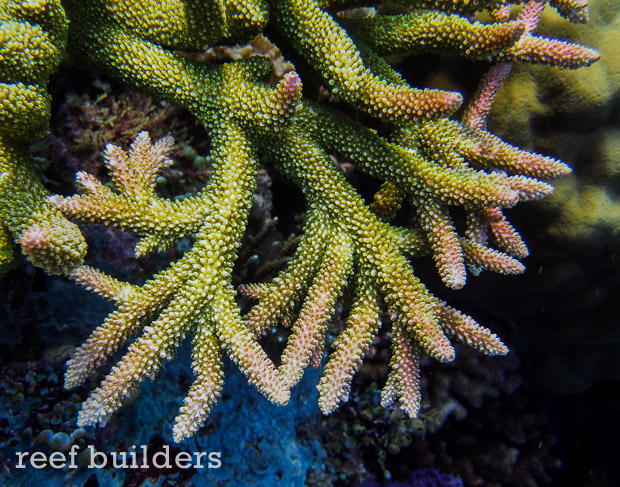Acropora robusta is an interesting, thick branching staghorn coral which also happens to grow crazy fast in a high energy reef tank, especially when it is provided with “maximal” speeds for an aquarium. Often confused for Acropora abrotanoides, the main feature which makes A. robusta distinct is its penchant for growing mostly horizontal branches that spread out and create a nice cushion of a flattened staghorn coral colony.
 While the pink-tipped green Acropora robusta staghorn is relatively “common” in the aquarium hobby, nearly all of the colonies are actually maricultured and it is believed that they all hail from a single colony that was harvested by Vincent Chalias over a decade ago. Vincent who helped to organize the Fluval Sea Flores Expedition was our dive partner on this one particular dive in an extremely high flow environment where we got to see a wild colony of Acropora robusta for the first time.
While the pink-tipped green Acropora robusta staghorn is relatively “common” in the aquarium hobby, nearly all of the colonies are actually maricultured and it is believed that they all hail from a single colony that was harvested by Vincent Chalias over a decade ago. Vincent who helped to organize the Fluval Sea Flores Expedition was our dive partner on this one particular dive in an extremely high flow environment where we got to see a wild colony of Acropora robusta for the first time.
On this particular dive we caught the tide at the “wrong” time and were subjected to a high speed drift dive which moved water along at a clip of at least one meter per second, that’s roughly three feet of water motion per second. In these conditions it was very hard to spot unique coral colonies on the reef as we whizzed by but this stunning colony of Acropora robusta really caught our eye from a distance.
 In this kind of challenging water speed and force it was necessary to use reef hooks to clip into the reef to remain stationary enough to observe any coral, let alone to stop and steady ourselves enough for usable photography. Clearly we were experiencing this incredibly lush reefscape during one of its highest flow periods but still, the importance of water flow for the health and vitality of corals like Acropora robusta cannot be overstated.
In this kind of challenging water speed and force it was necessary to use reef hooks to clip into the reef to remain stationary enough to observe any coral, let alone to stop and steady ourselves enough for usable photography. Clearly we were experiencing this incredibly lush reefscape during one of its highest flow periods but still, the importance of water flow for the health and vitality of corals like Acropora robusta cannot be overstated.
According to Vincent who has lived in Indonesia for nearly two decades, this is only the second wild pink and green Robusta staghorn coral he has ever encountered, even though his coral farm Bali Aquarium produces an incredible number of maricultured colonies of this species. It just goes to show that despite being a relatively available aquarium coral, mariculture has really enabled us stony coral diehards to enjoy rare corals which could not be sustainably harvested as wild colonies, and now the genetics of this coral have spread far and wide beyond the species’ natural range.




